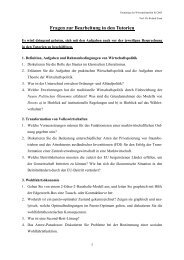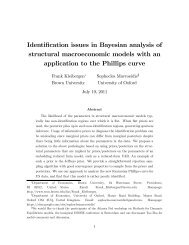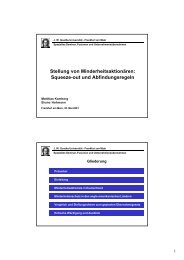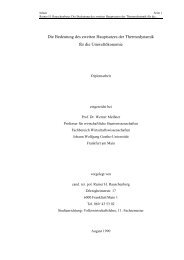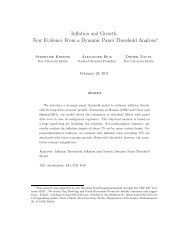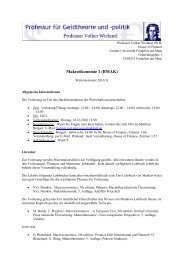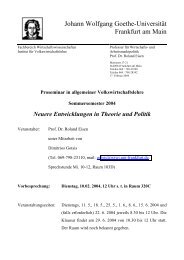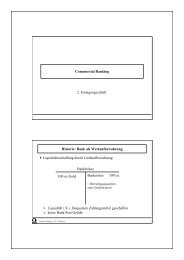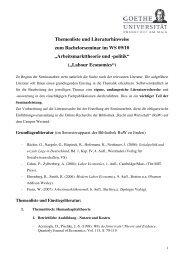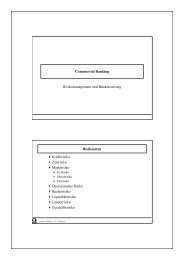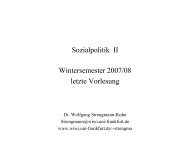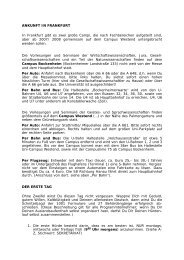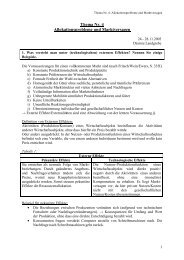Calvo vs. Rotemberg in a Trend Inflation World - Wiwi Uni-Frankfurt
Calvo vs. Rotemberg in a Trend Inflation World - Wiwi Uni-Frankfurt
Calvo vs. Rotemberg in a Trend Inflation World - Wiwi Uni-Frankfurt
You also want an ePaper? Increase the reach of your titles
YUMPU automatically turns print PDFs into web optimized ePapers that Google loves.
of view. Then, we plot the determ<strong>in</strong>acy regions conditional on our estimated models.<br />
We do so by calibrat<strong>in</strong>g each model we focus on with its estimated posterior means, with<br />
the exception of the Taylor parameters and y, which we vary <strong>in</strong> order to explore<br />
each model’s determ<strong>in</strong>acy territory. This is equivalent to condition<strong>in</strong>g our exercise to<br />
the most plausible calibration (given the sample at hand) among the set of <strong>in</strong>…nite<br />
parameterizations available. Our aim is to understand how relevant the di¤erence <strong>in</strong><br />
terms of determ<strong>in</strong>acy regions is from an empirical standpo<strong>in</strong>t.<br />
We consider the best …tt<strong>in</strong>g versions of the <strong>Calvo</strong> and <strong>Rotemberg</strong> models, i.e. (i)<br />
the <strong>Calvo</strong> model with = 1 and = 0, and the (ii) the <strong>Rotemberg</strong> model with = 1<br />
and = 0:38: To have a sense of the impact that trend <strong>in</strong>‡ation actually exerts on<br />
the determ<strong>in</strong>acy regions, we also consider (iii) the basel<strong>in</strong>e New-Keynesian model with<br />
= = 1, our "basel<strong>in</strong>e" model. It is useful to recall that, under full <strong>in</strong>dexation,<br />
<strong>Calvo</strong> and <strong>Rotemberg</strong> collapse to the same reduce-form dynamics, then the di¤erences<br />
<strong>in</strong> terms of determ<strong>in</strong>acy region disappear.<br />
Figure 3 plots the determ<strong>in</strong>acy regions of the three models. The basel<strong>in</strong>e model,<br />
which is conditional on full <strong>in</strong>dexation, recovers the standard Taylor pr<strong>in</strong>ciple to have<br />
a unique equilibrium under rational expectations: > 1: Our estimates, however,<br />
suggests that the degree of <strong>in</strong>dexation is full neither under <strong>Calvo</strong> nor under <strong>Rotemberg</strong><br />
pric<strong>in</strong>g. Consequently, the determ<strong>in</strong>acy regions under these two estimated frameworks<br />
look quite di¤erent. Indeed, the estimated <strong>Calvo</strong> model delivers a quite smaller deter-<br />
m<strong>in</strong>acy region. This translates <strong>in</strong>to a substantial reduction of the set of implementable<br />
rules, and calls for a hawkish behavior by monetary policymakers not to trigger self-<br />
ful…ll<strong>in</strong>g ‡uctuations. This prediction is <strong>in</strong> stark contrast with the one com<strong>in</strong>g from<br />
the <strong>Rotemberg</strong> model, which suggests a counter-clockwise rotation conditional on the<br />
estimated degree of <strong>in</strong>dexation (as well as the rema<strong>in</strong><strong>in</strong>g structural parameters), and<br />
an enlargement of the set of policy rules which guarantee equilibrium uniqueness.<br />
22



